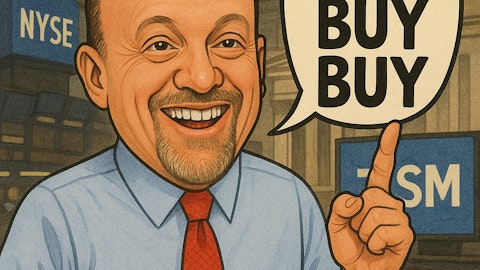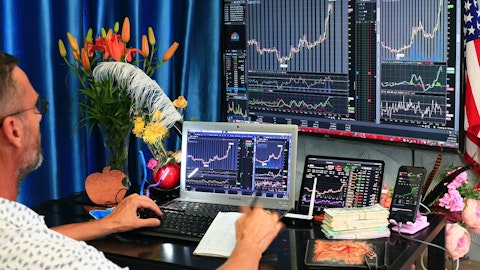In this article, we will discuss the 10 Worst Blue Chip Stocks to Buy.
As per Niamh Brodie-Machura, Co-Chief Investment Officer at Fidelity International, the effect of tariffs is expected to shift lower as and when the deals are made, supply chains adapt, and there is some adjustment in consumption patterns with lower tariffed goods witnessing relatively increased demand. However, there continues to be a period of increased volatility, and investors who plan to add risk should be careful. The environment is more of an opportunity to better position portfolios for resilience amidst uncertainty.
Market Rotation and Opportunity Areas
Contrary to expectations, BlackRock, in its release dated April 23, highlighted that international equities outperformed the US equities by 11% in 2025. The US growth stocks fell by 10%, and US value stocks increased by 2%. This transition demonstrates a significant market rotation throughout geography and style as value stocks continue to gain favor over growth stocks. Within the US market, value equities, mainly in defensive sectors such as healthcare, have been performing well, says the asset manager.
BlackRock also added that the narrowing of the earnings gap and the industry’s attractive characteristics, like innovation and the growth of aging populations, have been fueling the performance. Notably, active management strategies are advantageous when it comes to navigating the fluctuating markets.
READ ALSO: 7 Best Stocks to Buy For Long-Term and 8 Cheap Jim Cramer Stocks to Invest In.
What Should Investors Do?
BlackRock believes that the US large-cap value equities are the only major US index having positive returns YTD through March 31. Among the value equities, its investors are spotting opportunities in defensive sectors. In the current fast-moving political environment, primarily new trade policies, value equities can possess an additional tailwind. This stems from their ability to fetch a greater share of revenue from the US.
Elsewhere, if tariff discussions continue longer than expected or the average tariff rates differ from the current expectations, it is important to make portfolio changes accordingly, says Fiduciary Trust (a privately held wealth management firm). Notably, the capex spending on AI is expected to remain strong, and AI will likely fuel long-term productivity. The firm also opines that changes will be made to bank capital ratio rules, enabling them to enhance lending and/or increase stock buybacks. Both of these measures can improve earnings.
Amidst such trends, let us now have a look at the 10 Worst Blue Chip Stocks to Buy.

Our Methodology
To list the 10 Worst Blue Chip Stocks to Buy, we scanned through the holdings of SPDR® S&P 500® ETF Trust and chose the ones that declined between 15%-30% on a YTD basis. After getting an extended list of stocks, we selected the ones popular among hedge funds. Finally, the stocks were ranked in ascending order of their hedge fund holdings, as of Q4 2024.
Why are we interested in the stocks that hedge funds pile into? The reason is simple: our research has shown that we can outperform the market by imitating the top stock picks of the best hedge funds. Our quarterly newsletter’s strategy selects 14 small-cap and large-cap stocks every quarter and has returned 373.4% since May 2014, beating its benchmark by 218 percentage points (see more details here).
10 Worst Blue Chip Stocks to Buy
10. Target Corporation (NYSE:TGT)
Number of Hedge Fund Holders: 56
% Decline on a YTD Basis: ~29.7%
Target Corporation (NYSE:TGT) operates as a general merchandise retailer. Analyst Mavis Hui from DBS reiterated a “Buy” rating on the company’s stock, keeping the price objective at $188.00. The analyst’s rating is backed by factors demonstrating the company’s healthy performance and strategic initiatives. A YoY increase in adjusted EPS was aided by a recovery in customer traffic and gross margins’ improvements, added the analyst. Target Corporation (NYSE:TGT)’s emphasis on omni-channel growth remains a critical factor in the analyst’s rating. The company continues to enhance its online and offline sales integration.
Furthermore, the investments in store remodeling and partnerships with well-established brands such as Apple and Disney can fuel both online and in-store sales, says the analyst. Target Corporation (NYSE:TGT)’s efficient use of physical stores as logistics centers led to reduced delivery costs, which can offset the potential margin pressures, added Hui. Despite worries related to the inflationary pressures, Target Corporation (NYSE:TGT)’s robust customer loyalty and operational efficiency improvements support a favourable outlook for growth in future earnings. The company’s digital initiatives can offer valuable data insights, allowing it to optimize inventory management, personalize offerings, and improve operational efficiency. Target Corporation (NYSE:TGT)’s investments in supply chain enhancements and inventory management systems can also result in operational efficiency.
9. United Parcel Service, Inc. (NYSE:UPS)
Number of Hedge Fund Holders: 59
% Decline on a YTD Basis: ~22.6%
United Parcel Service, Inc. (NYSE:UPS) is a package delivery and logistics provider that provides transportation and delivery services. Analyst Fadi Chamoun from BMO Capital maintained a “Buy” rating on the company’s stock, having a price objective of $125.00. This rating highlights the company’s strategic initiatives and financial performance. Despite the tough macroeconomic environment, United Parcel Service, Inc. (NYSE:UPS)’s Q1 2025 results marginally surpassed expectations. The analyst opines that this was aided by healthy performance in the US Domestic segment.
Furthermore, its emphasis on cost reduction and capital reallocation towards higher-margin supply chain solutions, like healthcare, can mitigate macroeconomic headwinds and enhance its overall profitability. Chamoun also added that, despite some short-term pressures, United Parcel Service, Inc. (NYSE:UPS)’s strategic transition from lower-margin B2C volumes towards higher-value-added products can be beneficial for the company’s margins and ROIC over the long run. Overall, such strategic steps and targeted cost savings strengthen the analyst’s confidence in the company’s future performance.
Elsewhere, Wells Fargo & Company reissued an “Equal weight” rating and gave a price objective of $98.00 on the company’s stock on April 22. River Road Asset Management, an investment management company, released its Q4 2024 investor letter. Here is what the fund said:
“As of December 31, the portfolio held 29 positions, up four positions from Q3. During Q4, the largest sector increase was 736 bps within industrials, while the largest decrease was -276 bps within consumer discretionary. We established five new positions and eliminated one position
We also initiated a position in United Parcel Service, Inc. (NYSE:UPS) (Cl B) (UPS, 3.0 conviction), the world’s largest package delivery company, which handles over six billion packages annually and can reach 90% of the world’s gross domestic product (GDP) within a day. After years of elevated network investments to expand capacity, UPS has refocused its strategy on growing return on invested capital (ROIC). We believe the stock will rerate higher as margins, which we believe have bottomed, are expected to expand with the price per package growing faster than the cost per package. In the interim, investors collect a 5% dividend, which has grown in 21 out of 24 years since UPS went public. The dividend is supported by healthy free cash flow and an investment grade balance sheet with ~1x net leverage.”
8. Hewlett Packard Enterprise Company (NYSE:HPE)
Number of Hedge Fund Holders: 66
% Decline on a YTD Basis: ~21.4%
Hewlett Packard Enterprise Company (NYSE:HPE) is a supplier of IT infrastructure products and services. Bank of America Securities analyst Wamsi Mohan maintained a “Buy” rating on the company’s stock, setting a price objective of $20.00. The analyst’s rating is backed by several factors demonstrating Hewlett Packard Enterprise Company (NYSE:HPE)’s potential for value creation. The analyst believes that the involvement of activist investor Elliott Management exhibits a belief in the company’s undervaluation as compared to peers. Notably, Reuters reported that Elliott Investment Management built a stake of over $1.5 billion in the company.
Hewlett Packard Enterprise Company (NYSE:HPE)’s investment in liquid cooling technology for AI servers provides a strong opportunity for growth in the competitive AI hardware market. With AI workloads becoming complex and power-intensive, the traditional air cooling solutions have been reaching limits. Therefore, liquid cooling provides numerous advantages that can fuel Hewlett Packard Enterprise Company (NYSE:HPE)’s success. Through managing heat more effectively, liquid-cooled systems have the ability to decrease energy consumption. This can lead to reduced operating costs for customers. Overall, the company continues to operate in a dynamic industry environment. The broader enterprise IT market continues to exhibit signs of recovery, with higher infrastructure spending as well as digital transformation initiatives. Such trends are likely to bode well for the company’s core business segments.
7. FedEx Corporation (NYSE:FDX)
Number of Hedge Fund Holders: 66
% Decline on a YTD Basis: ~20.5%
FedEx Corporation (NYSE:FDX) offers transportation, e-commerce, and business services in the US and internationally. Analyst Ken Hoexter of Bank of America Securities reiterated a “Buy” rating on the company’s stock with a price objective of $272.00. The analyst’s rating is backed by a combination of factors demonstrating FedEx Corporation (NYSE:FDX)’s efforts in cost savings and operational efficiencies. The analyst highlighted that despite worries related to the macroeconomic uncertainties and inflationary pressures, it made strong progress in its DRIVE cost savings initiatives, achieving $600 million in savings in Q3 2025.
Furthermore, FedEx Corporation (NYSE:FDX) continues to advance its Network 2.0 transformation and Tricolor initiatives, which can further improve operational efficiencies. Despite the weak industrial economy impacting the company’s business-to-business volumes, its strategic initiatives are regarded as a favourable catalyst for future growth, added Hoexter. FedEx Corporation (NYSE:FDX) continues to make healthy progress on decreasing its cost to serve and improving operational performance, mainly at Federal Express, aiding operating income and earnings growth.
Longleaf Partners, managed by Southeastern Asset Management, released its Q1 2025 investor letter. Here is what the fund said:
“FedEx Corporation (NYSE:FDX) – Global logistics company FedEx was a detractor for the quarter. The company faced macro headwinds, including tariff threats and ongoing demand weakness in the US. The company is growing market share and margins in its formerly challenged European business, and this was a driver for the Express business to report low-single-digit topline growth that turned into double-digit cash flow growth. The Freight business saw a decline like its peers who are also wrestling with weak industrial conditions. FedEx remains on track to separate into two entities: Express and Freight. This split should provide both companies with greater financial flexibility and accountability, allowing them to be run more efficiently. The market has consistently undervalued FedEx’s Freight operations, and a large discount to UPS is no longer warranted for the Express business. Tariff headwinds will be challenging to navigate, but we are glad the company is more on offense now than it has been in previous downturns.”
6. Regeneron Pharmaceuticals, Inc. (NASDAQ:REGN)
Number of Hedge Fund Holders: 68
% Decline on a YTD Basis: ~26.2%
Regeneron Pharmaceuticals, Inc. (NASDAQ:REGN) discovers, invents, develops, manufactures, and commercializes medicines for treating various diseases worldwide. Analyst John Newman from Canaccord Genuity maintained a “Buy” rating on the company’s stock and has a price objective of $850.00. The analyst’s rating is backed by several factors affecting its stock price. Despite the challenges related to the EYLEA product line, the analyst views potential in Regeneron Pharmaceuticals, Inc. (NASDAQ:REGN)’s long-term growth prospects. Furthermore, the Factor XI program has also been highlighted as a significant opportunity by the firm’s analyst. Overall, the analyst’s positive outlook stems from the company’s ability to diversify revenue streams and capitalize on new market opportunities.
Coming to hematology, the company has been advancing its Factor XI program, where it continues to investigate 2 different antibodies targeting different factor XI domains in order to create a tailored approach to anticoagulation, providing potential for improved blood clot prevention and lower bleeding risk. In April 2025, the US FDA approved Dupixent for the treatment of adults and adolescents who are 12 years of age and older with CSU who remain symptomatic despite antihistamine treatment. Regeneron Pharmaceuticals, Inc. (NASDAQ:REGN) also highlighted that, in March 2025, Japan’s Ministry of Health, Labour and Welfare (MHLW) approved Dupixent for treating patients with COPD.
Baron Funds, an investment management company, released its Q3 2024 investor letter. Here is what the fund said:
“We purchased Regeneron Pharmaceuticals, Inc. (NASDAQ:REGN), a biopharmaceutical company that was built on a foundation in basic scientific research and antibody development. The company has successfully developed several blockbuster medicines, including Eylea and Eylea HD for retinal diseases (such as wet age-related macular degeneration, diabetic macular edema, and diabetic retinopathy) and Dupixent for immunological and inflammatory diseases (such as atopic dermatitis, asthma, and COPD). While Eylea is nearing the end of its patent life and faces potential biosimilar competition, the company has been transitioning patients to Eylea HD, which is a higher dose, longer-acting formulation of Eylea, and Dupixent is growing rapidly through indication expansion. Beyond the current product portfolio, Regeneron has an exciting new product pipeline with over 35 candidates in various stages of development, including a novel treatment for treating severe food allergy, a combination checkpoint inhibitor therapy for melanoma, lung cancer and other solid tumors, biospecific antibodies for blood cancers, and Factor XI antibodies for blood clot prevention, among others. Based on Regeneron’s track record of success discovering and developing new drugs, we are optimistic the pipeline will deliver some successes, which we think will drive upside in the stock.”
5. NIKE, Inc. (NYSE:NKE)
Number of Hedge Fund Holders: 73
% Decline on a YTD Basis: ~20.3%
NIKE, Inc. (NYSE:NKE) is engaged in the designing, developing, marketing, and selling of athletic footwear, apparel, equipment, accessories, and services. Lorraine Hutchinson from Bank of America Securities reiterated a “Buy” rating on the company’s stock with a price objective of $80.00. The rating comes off the back of NIKE, Inc. (NYSE:NKE)’s promising progress in critical areas as well as strategic initiatives to fuel growth. Its leadership exhibited early success in categories such as running, and the company continues to engage with wholesale partners in order to gather feedback on upcoming products, says the analyst.
NIKE, Inc. (NYSE:NKE)’s marketing efforts are expected to fuel brand visibility and sales momentum. As per the analyst, the inventory management can further aid innovation and result in a healthy increase in sales. Furthermore, NIKE, Inc. (NYSE:NKE)’s proactive approach to navigate tariffs through adjustment of sourcing strategy and leveraging healthy vendor relationships places it well to manage external challenges, says Hutchinson. Also, the company’s scale offers a competitive advantage, enabling it to leverage consumer insights as well as maintain robust supplier relationships.
RiverPark Advisors, an investment advisory firm and sponsor of the RiverPark family of mutual funds, released its Q4 2024 investor letter. Here is what the fund said:
“NIKE, Inc. (NYSE:NKE): NKE shares were a top detractor in the quarter following better than expected fiscal second quarter results reported in December but worse than feared third quarter guidance. The company delivered $13.4 billion of revenue (roughly $1 billion better than expectations) and $1.9 billion of EBIT (roughly $500 million ahead of street consensus) and generated better than expected earnings of $1.03 (investors were looking for $0.78). Despite better operating metrics last quarter, the company dramatically lowered expectations for the fiscal third quarter including expectations for double-digit percentage declines in revenue. NKE’s new CEO, Elliot Hill, described several key issues negatively impacting the company’s growth trajectory including 1) a multi-year move away from a focus on sports, 2) a shift away from innovative demand creating marketing, 3) too much centralization, which has led to lack of execution capabilities in local markets, and 4) too much focus on Nike Digital, which negatively impacted the brands standing in the marketplace.
Nike is, by far, the leading athletic footwear, apparel, and equipment company in the world with over $50 billion in revenue, $6.7 billion in FY2024 annual free cash flow, and $10 billion of excess cash. We believe that over the long term, the global secular growth trend towards active wear will continue to aid Nike’s top-line growth driving gross and operating margin improvements and long-term mid-teens or higher annual EPS growth. In the short term, we believe that the company will work through the above headwinds and that revenue and earnings growth will reaccelerate in the next 12 months.”
4. KKR & Co. Inc. (NYSE:KKR)
Number of Hedge Fund Holders: 83
% Decline on a YTD Basis: ~20.8%
KKR & Co. Inc. (NYSE:KKR) is a private equity and real estate investment firm that specializes in direct and fund-of-fund investments. Michael Brown, an analyst from Wells Fargo, maintained a “Buy” rating on the company’s stock and the associated price target was $120.00. The analyst’s rating comes off the back of factors such as the launch of KKR/Capital credit interval funds, which can fuel significant inflows across the year. As per the analyst, the partnership with Capital is being regarded as a strategic move that can enhance KKR & Co. Inc. (NYSE:KKR)’s market position, while more fund offerings are expected in the future. Amidst the market volatility, monetization activities remained steady, reflecting resilience in the company’s operations.
Elsewhere, Wells Fargo remains confident in KKR & Co. Inc. (NYSE:KKR)’s ability to capitalize on the anticipated fundraising supercycle and offer growth amidst the expected positive changes in the broader investment landscape. Given the company’s healthy brand reputation, it can attract robust capital inflows, resulting in strong growth in AUM. The increased capital base can help generate higher management fees and can offer KKR & Co. Inc. (NYSE:KKR) more opportunities for attractive investments throughout its strategies. Also, its diverse product offerings and global reach can help it capture a significant share of investor capital during the supercycle.
River Road Asset Management, an investment management company, released its Q4 2024 investor letter. Here is what the fund said:
“Another positive contributor was KKR & Co. Inc. (NYSE:KKR), a leading global alternative asset manager. Institutions have sought out KKR’s dynamic investment expertise for nearly 50 years. The company’s AUM has grown at a 20% CAGR since 2011 as it has broadened its product line-up to include infrastructure, real estate, credit, and liquid strategies for the mass market. Over 90% of the company’s assets are “locked-up” for at least eight years and over 50% are perpetual. Insiders own 36% of the company, and we believe the balance sheet is rock solid with net cash and ~30% of its market cap represented by illiquid investments, that will soon begin paying material dividends to KKR.
KKR’s stock performance in Q4 was driven by exceptional growth across key metrics, with Fee Related Earnings surging 79% year over-year at an impressive 71% margin, while Total Operating Earnings grew 37%, demonstrating the increasing durability of earnings with 81% coming from recurring sources. The company’s fundraising momentum remained strong with $24B raised in the quarter ($85B year-to-date as of September 30, 2024), while assets under management (AUM) grew 18% year-over-year to record levels, driven by strength in infrastructure (growing from $13B to $77B), credit ($240B AUM), and Asia ($70B AUM). Management’s successful execution across multiple growth initiatives, including the expansion of retail products and strategic holdings, combined with improving realization opportunities and capital markets activity ($424MM in Q3), reinforces the company’s path to potentially significant earnings growth with management projecting potential adjusted net income of $7 per share by 2026. We maintained the position.”
3. Merck & Co., Inc. (NYSE:MRK)
Number of Hedge Fund Holders: 91
% Decline on a YTD Basis: ~23.3%
Merck & Co., Inc. (NYSE:MRK) is a leading global healthcare company. Bank of America Securities analyst Tim Anderson reiterated a “Buy” rating on the company’s stock, setting a price objective of $99.00. The analyst’s rating is backed by factors demonstrating the company’s growth potential and undervaluation. Despite the minor impacts from tariffs and foreign exchange in Q1 2025, the analyst believes that overall financial performance is robust. Also, Anderson opines that Merck & Co., Inc. (NYSE:MRK)’s stock remains undervalued given the growth prospects and strong pipeline. The company has made healthy progress to start the year, with higher contributions from its newer commercialized medicines and vaccines and continued advancement of the pipeline.
KEYTRUDA sales saw an increase of 6% YoY (excluding the impact of foreign exchange) in Q1 2025. The growth was aided by higher global uptake in earlier-stage indications, which include triple-negative breast cancer, renal cell carcinoma, and non-small cell lung cancer, and continued robust global demand from metastatic indications, which include increased uptake in bladder, endometrial, and microsatellite instability-high (MSI-H) cancers, partially mitigated by the timing of wholesaler purchases in the US. Overall, Merck & Co., Inc. (NYSE:MRK)’s emphasis on oncology, vaccines, and emerging therapeutic areas places it well to capitalize on increasing healthcare needs.
GreensKeeper Asset Management, an investment management company, released its Q3 2024 investor letter. Here is what the fund said:
“Merck & Co., Inc. (NYSE:MRK) was our second-largest detractor this quarter, declining -8.3%. MRK’s leading HPV vaccine, GARDASIL 9, faced challenges internationally due to inventory buildup within its Chinese distributor, which is expected to reduce shipments for the remainder of 2024. Despite this short-term impact, the long-term outlook for GARDASIL 9 remains promising. Meanwhile, the company’s $27 billion Keytruda cancer juggernaut continues to grow at a healthy clip, powering earnings growth.”
2. Tesla, Inc. (NASDAQ:TSLA)
Number of Hedge Fund Holders: 126
% Decline on a YTD Basis: ~21.5%
Morgan Stanley analyst Adam Jonas recently maintained a “Buy” rating on Tesla, Inc. (NASDAQ:TSLA)’s stock, setting a price objective of $410.00. The analyst’s rating stems from factors demonstrating the company’s strategic positioning in the evolving manufacturing landscape. The integration of AI and advanced manufacturing technologies continue to reshape the broader industry, and Tesla, Inc. (NASDAQ:TSLA) is the frontrunner of this transformation, says Jonas. By leveraging AI and robotics, the company remains well-placed to capitalize on the resurgence of US manufacturing, which remains in line with the vision of establishing cutting-edge factories domestically.
The analyst further opines that the transition in manufacturing is not about reducing costs, but about embracing technological advancements to create factories of the future. Tesla, Inc. (NASDAQ:TSLA)’s commitment to innovation, together with its capability to implement AI-driven solutions, places it as a leader in the new industrial era. This strategic advantage and Tesla, Inc. (NASDAQ:TSLA)’s ongoing developments support the analyst’s positive outlook.
Baron Funds, an investment management firm, released its Q1 2025 investor letter. Here is what the fund said:
“Tesla, Inc. (NASDAQ:TSLA) manufactures electric vehicles (EVs), solar products, and energy storage solutions alongside the development of advanced real-world AI technologies. Shares fell due to declining analyst expectations for auto delivery volume and margins in 2025 as a result of 1) a refresh of the Model Y, its highest volume vehicle and the world’s best selling car in 2024; 2) Elon Musk’s controversial role in the Trump administration; and 3) regulatory changes that could pose potential operational challenges. Despite these headwinds, we remain confident in Tesla’s long-term growth, underpinned by secular trends in EVs and energy storage adoption, a compelling product line, its leading cost structure, and cutting-edge technology. A Model Y refresh alongside the debut of new mass-market models should boost demand. Over time, we expect the political pressure to fade, while Tesla’s AI ambitions—a robotaxi service launching this year and a fast-growing humanoid program—hold the promise of transforming its growth story.”
1. Apple Inc. (NASDAQ:AAPL)
Number of Hedge Fund Holders: 166
% Decline on a YTD Basis: ~18.7%
Wamsi Mohan, an analyst from Bank of America Securities, recently reiterated a “Buy” rating on Apple Inc. (NASDAQ:AAPL)’s stock. The analyst’s rating is backed by a combination of factors, including its recent fall in stock price on a YTD basis. The analyst has highlighted the company’s stable cash flows and earnings resiliency, together with potential benefits from AI advancements. Furthermore, despite geopolitical worries and tariff risks, Apple Inc. (NASDAQ:AAPL) possesses strategies to mitigate risks, like diversification of the supply chain and adjustment of pricing strategies.
Elsewhere, Citi analyst Atif Malik maintained a “Buy” rating on the company’s stock, setting a price objective of $240.00. This rating is backed by a combination of factors reflecting Apple Inc. (NASDAQ:AAPL)’s strategic positioning and future growth potential. One of the key reasons is the company’s proactive approach to diversifying search engine partnerships. This is evident from its discussions with several AI providers for the integration of AI search features into Safari, says the analyst. Furthermore, the integration of AI search providers can offer new revenue-sharing opportunities.
Columbia Threadneedle Investments, an investment management company, published its Q4 2024 investor letter. Here is what the fund said:
“The fund maintained a position in Apple Inc. (NASDAQ:AAPL) throughout the quarter through the release of the company’s new iPhone 16 in September. Company leaders were excited about the release of the new model, as this is the first model that will feature enhanced AI capabilities through the Apple Intelligence features. Sales for the first few weeks in October and November trailed behind year over year sales from the iPhone 15, as availability of Apple Intelligence was not compatible with all iPhone models. Apple announced a partnership with OpenAI that has allowed the integration of ChatGPT into the Apple ecosystem, separate from the core Apple Intelligence features. This partnership highlights continued progress from Apple to introduce AI capabilities into its products and we expect the iPhone 17 to have even more expansive AI capabilities, increasing potential demand for the new model that is on track to be released in 2025.”
While we acknowledge the potential of AAPL as an investment, our conviction lies in the belief that some deeply undervalued AI stocks hold greater promise for delivering higher returns, and doing so within a shorter time frame. There is an AI stock that went up since the beginning of 2025, while popular AI stocks lost around 25%. If you are looking for a deeply undervalued AI stock that is more promising than AAPL but that trades at less than 5 times its earnings, check out our report about this cheapest AI stock.
READ NEXT: 20 Best AI Stocks To Buy Now and 30 Best Stocks to Buy Now According to Billionaires.
Disclosure: None. Insider Monkey focuses on uncovering the best investment ideas of hedge funds and investors. Please subscribe to our daily free newsletter to get the latest investment ideas from hedge funds’ investor letters by entering your email address below.





